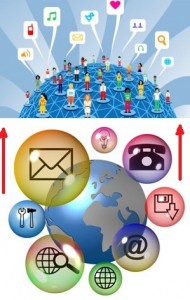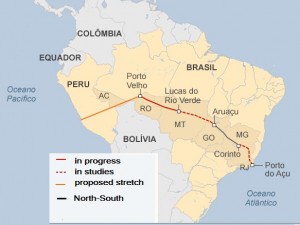
Arquivo para May, 2015
Infernal dichotomies and technology
Modern thought lives under the aegis of the infernal dichotomies (subjective vs objective, nature vs culture), a term coined by Bruno Latour to explain the thought and the sciences of today, nothing more conducive.
nature vs culture), a term coined by Bruno Latour to explain the thought and the sciences of today, nothing more conducive.
The whole theory of the modern state, as Thomas Hobbes, who said that man is a homine lupus (wolf to man) through the empiricist John Locke, until you reach Jean Jacques Rousseau, who said that man by nature is good, the noble savage, which He inspired the French Revolution, but what followed it was one bloodthirsty killing and then there were two restorations of the monarchy.
Nothing more propitious time we designed the objects, our modern fetishes and time designed the subject, our passions and everyday affairs, but the question of being, that is, the essence of our existence remains unnoticed.
Of course the fetish of all fetishes is money for some so it can provide, but for most people just get pay day to day bills, and the pile of benefits that swelled in recent years, called by some of middle-class forward, it seems that the fetish disbanded.
Here are questions the technological fetishes, to what extent part of a contemporary need, to what extent are mere fetishes, is questionable communicate is necessary, but the iPhone last type is at hand often critical of “consumerism”.
As always beyond subject and object, to forget the existential Being, there is confusion between culture and nature, it is natural to man to communicate and it is cultural to use device that facilitates this communication, said the contemporary philosopher Heidegger man makes himself the language .
We must have a contemporary language or are we talking about for the past century.
Brazilians soccer corruption
In the night of Wednesday to Thursday in Brazilian time, morning and Switzerland in a special operation, seven major FIFA executives were arrested on charges of corruption, including José Maria Marin, former president and current vice CBF.
major FIFA executives were arrested on charges of corruption, including José Maria Marin, former president and current vice CBF.
On Friday would be the election of new leaders of FIFA, in addition to 7 more defendants leaders are accused of extortion, fraud and conspiracy to launder money, also a search warrant at the headquarters of CONCACAF (Caribbean and Central and North America Confederation) in Miami was issued.
Corruption happened to the marketing rights and the Brazilian J.Hawilla, owner of Traffic, sports marketing company, is among the accused in addition to the leaders as early as December 2014 answered a process and the time has agreed to pay 151 million dollars.
In Brazil, Romario deputy, former player who played and won the World Cup 1994 in the United States, got the signatures to make a Investigation Comission (cpi) Brazilian 2014 World Soccer Cup, may finally have the truth about the fun splurges and made with public money during the World Cup , it will come the moment of truth.
Romario prefaced the book “O lado sujo do Futebol” (in english The dirty side of football) perhaps the country needs begin to change from the greatest passion of the brazilians: soccer.
5 technologies that will change the world
The World Economic Forum experts brought together 18 experts and 10 innovations listed, highlight  five and comment other five concern.
five and comment other five concern.
Powered hydrogen cars was a promise, experts now warn “only now the technology seems to have reached the point where manufacturers plan to incorporate it into releases for consumers.”
Only present in plants and simple tasks (how to collect dust), now the thousands of better and cheaper sensors will allow “robots are able to understand and respond to the environment around it. Their ‘bodies’ are becoming more adaptable and flexible, “said the experts.
Plastic “thermoset” make recycling undergoing a process once, which gives both durability and ease of recycling, their use in mobile phones, computers and aircraft, will change its recycling.
The artificial intelligence with smartphones recognizing the voice of its owner, cars that drive themselves or drones are already present, though experts had who are “stepping forward with machines able to learn independently assimilate large volumes of information” , inform the experts.
The idea of decentralized manufacturing grew, you can now think of “smaller factories and locations receive instructions for making parts that can be assembled by the consumer or workshops own,” explains the forum.
The five possible forecasts more questionable is the “new techniques allow ‘edit’ the genetic code of plants to make them more nutritious or resistant to climate change,” the 3D additive manufacturing where “manufactured thus can be highly customized for each user, unlike products made with mass manufacturing processes, “the neuromorphic technology that could make a” transfer data between a memory and a central processor is that it uses large amounts of energy and generate a lot of heat “and intelligent autonomous drones.
Each of these last 5 has an outstanding period is the social disarray.
Gartner curve and technologies
Gartner research foundation published his Hypo Cycle in 2014, and among its forecasts (taken debatable of course, for example, HTML5 is already a reality) seems that within two years we will have assistants to usable voice, 3D scanners in fast movement, reality in virtual layers in the “valley of disappointment”, the NFC is still stuck in the valley, which reminds me that we will see the iPhone 6 rise with a machine translation of voice, while still very slow, but at the end of maturity curve (speech recognition) and the beginning of the productivity curve.
(taken debatable of course, for example, HTML5 is already a reality) seems that within two years we will have assistants to usable voice, 3D scanners in fast movement, reality in virtual layers in the “valley of disappointment”, the NFC is still stuck in the valley, which reminds me that we will see the iPhone 6 rise with a machine translation of voice, while still very slow, but at the end of maturity curve (speech recognition) and the beginning of the productivity curve.
The Internet of Things is at the peak of expectations, but then enters the valley of disappointment, and autonomous vehicles are already getting a little behind this peak, while gamification and augmented reality (virtual glasses are part of it) are in full diving in the valley the disappointment, but then they must take the ramp maturity.
Among the high expectations of the future, one highlight is the volumetric display holograms, quantum computing and the three-dimensional bioprinting able to create organic compounds and maybe even woven into three dimensional format, while only prostheses and three-dimensional molds.
On the other hand, three-dimensional scanners and printers on an industrial scale are already in the maturation curve and should achieve major market groups in the very near future.
They must be mature in the next two years the computing cloud and the proximity communication devices (Near Field Communication), while in the next five years will be in the market Communication Machine-to-machine and monitoring of health from a distance, of course this in part is already done, but still lack maturity.
Of course are only predictions, there are other search the curve
Curve of Tecnologies adoption
The so-called Hype Cycle is a graphic presentation developed by Gartner to represent the appearance of cycles, 
adoption, maturity and social application of specific technologies and can be used for investments and IT adoption in companies.
After the emergence and adoption by the market a technology must be accompanied by observing the cases of success and failure when it reaches a product, observe what happens in the inflated expectations of Pico is important to note the following point drop.
The next moment is marked by a fall by distrust of the market and must be carefully studied until the time it reaches the Peak of Trough of Disillusionment.
Then begins the time to maturity of the product and the market, it is easy to observe this moment, it is marked by a gentle Slope of Enlightenment.
The end of this curve is called the Plateau of Productivity in which the product is stable in the market and does not return to the previous period unless there is a obsolescence.
5 predictions that did not happen
IBM always makes five-year forecasts, before analyzing the 5 of the future (2015), let’s see if the 5 planned 2015 happened.
if the 5 planned 2015 happened.
1 – Sensors in every corner, comes from the Internet of things technology being called RSSF, there are already some cities, businesses and even smart homes, but in fact this has not happened is a developing technology.
2 Cars “breathe” – the idea is that it can use the air, some kind of fuel and return the air pure mode, drive batteries and transistors allow the drinking devices to recharge the battery, so she breathe oxygen and turn into energy, there are now new types of lithium battery, for example, and electrical but effective use is still a promise.
3 Computers used to “warm” water, energy dissipate computers, and currently in speed range of 5MHz reached the limit of silicon computers, but the lost thermal energy of computers is not “collected” not exploited.
4-3D holograms, technology is under development but is still promising, the problem is both the processing speed, are billion pixels per second to be processed, as the amount of energy expended, no devices on the market only in laboratories, which we are 3D printers already on the market.
5-Intelligent transit, emerge a new intelligent GPS technology that would be able to identify alternative routes for the driver if an accident happens on the way that the user is doing, there were apps like Waze to guide drivers and at Heathrow Airport in England already There intelligent cars, but the streets of London not.
Even with the use of computers as an aid, not even the most advanced intelligence can predict the future, there is unpredictability in history, but it’s not the end of history.
China Business
With a powerful but exploiting labor often slave industry, China is eyeing Latin America, and the impetus was given for the purchase of debt Argentina.
given for the purchase of debt Argentina.
The Chinese Premier Li Kegiang is in the region and started the visit on Monday by Brazil and will have stops in Colombia, Peru and Chile, which would be at stake beyond business.
In areas such as strategic planning, transport, infrastructure, energy and agriculture many agreements have been signed, but the big deal would be a walkway across Latin America in the construction of a railroad between the Atlantic and the Pacific, but the subject is controversial, because part is building or in progress.
The point is that the region is expected to grow less than 1% and the highway would be strategic for the entry of products and also to the flow of raw materials to countries with the greatest needs and industrializariam resending to Brazil products already with aggregate values and in this sense It would be just a “catwalk”.
The lack of infrastructure is precisely our biggest problem, but we can not sell us without getting a clear contrast, also ecological impacts should be thought.
The Transoceanic Railroad would cost is estimated at up to $ 10 billion (R$ 30 billion), can meet the needs of the various countries involved.
Down economy in Brazil: time to save
Several websites help consumers make savings in Brazil, compare products, shops, airline tickets, and there are those who give discount coupons for online stores, and show how to practice the best prices.
tickets, and there are those who give discount coupons for online stores, and show how to practice the best prices.
The Buscapé is undoubtedly one of the best sites to save, you will find it offers organized by category, if you want the best looking good this site.
Zoom and Bondfaro sites are strong competitors in the Buscapé comparison, a lesser-known but no less efficient the JáCotei, sites for buy in Brazil.
In order to provide comparative prices in supermarkets of São Paulo, Rio de Janeiro, Belo Horizonte, Curitiba and some local Santa Catarina Meu Carrinho application Buscapé group, compares prices of 25 networks registered supermarkets, such as: Extra, Balcony Zone South, Sugar Loaf, Delivery, probe, pricesa, Mercaorama, Angeloni and others
To help finance people with financial problems, debts, insurance, cards and consortiums, also with health and education, Konkero is a portal that can help users a lot.
To buy and sell cars, check list prices, analyze different regions of the country iCarro site is one of the most versatile.
There are countless websites for travel, tours and flights, it is best to find what the best for the region, namely that companies make flights, including the possible hosting locations and verify that the packages are not cheaper.
But do not forget credit cards only last if necessary, overdraft use is almost a usury (reaches over 200% per year) and see what fits in the budget do not forget to make reservations for emergencies: the brakes in bags.
5 myths about technology
While technology may have dangers, this is not unique to it, all means that man uses can cause deviant behavior,  addictions and consumerism, but almost everything we use is kind, from clothes, books and food, mobile phones, tablets and computers.
addictions and consumerism, but almost everything we use is kind, from clothes, books and food, mobile phones, tablets and computers.
Information online as Infomoney and Olhar Digital released its myths, only one I repeat here, the idea that mobile phone use causes brain cancer, there is no evidence of this, just coincidences of people who have used very mobile and had cancer, which It is different from proving that this is the cause.
The other 4 important are: the computer usage difficult to read, in fact make a different reading on the computer, it is a little tiring continuously read on the computer, but whole pages should be avoided, but the reading of e-books is practice many readers, but there are also those who prefer books and those who use them.
Another myth is that young people would be less going to libraries because the digital world, did a post with Pew Research Internet Project site data showing that this is false.
The fourth myth is that through the virtual world is opposed to the real, that unfortunately even sociologists and serious thinkers spread, first this is a logical error because the virtual is not opposed to real, not unreal, but only “potential” towards possible, with a lack of knowledge of the meaning of the word that comes from virtus, which is the same rais of virtue.
The fifth myth is that technology somehow opposes the construction of the human being, or even of humanism or anything positive for man, that is unaware that throughout human history technology has always sought to help the man, of course there are instruments of war, the atomic bomb etc, that is destructive technology, but beware of generalizations, almost everything we use clothing to work instruments, almost everything suffers and suffers constant technological change in order to improve the instrument.
The fifth is a philosophical myth of the West, the idea that everything is object is negligible and should not prevent direct human relationship, now just think of things from day to day: clothes, objects of our home, our work, books and of course their own money and technological objects, they are “impregnated” of humanity because they are part of our relationship Others, of course can be used positively or not, but this decision is up to man
Tongue in pieces
First run in São Paulo the show “A lingua em pedaços” (tongue in pieces) a work written by the Spanish Juan Mayorga, what’s playing on Friday, Saturday and Sunday at the Cultural Center Bank of Brazil talking about love, religion and misunderstanding, it’s about Teresa of Avila a nun who was also a poet and was proclaimed a saint by the Catholic church.
on Friday, Saturday and Sunday at the Cultural Center Bank of Brazil talking about love, religion and misunderstanding, it’s about Teresa of Avila a nun who was also a poet and was proclaimed a saint by the Catholic church.
The theme of the Inquisition which is usually seen only by non-Christians, now seen from the inside as Teresa of Avila was also a victim of these processes and many, many people who believe they are victims of various types of exclusion because they are religious.
The play “The Language in Pieces” then shows a fictional encounter between religious and an inquisitor who accuses her of subversion and heresy; it is not inversion of values, but to show that true Christians to the inquisition was rather absurd, the very Galileo Galilei, few know was religious, and the life of his daughter, religious Virginia, is in the book “Galileo’s Daughter,” writer by Dava Sobel.
Besides writer, Santa Teresa founded seventeen convents of Discalced Carmelites throughout Spain and ahead of its time, it was persecuted by the conservative sectors of the late sixteenth century.
The actor Antony Pâmio that makes the fictional Inquisitor explains his character: “It’s theatrical Santa Teresa was in fact persecuted by the Church But that man was created in the show so that the text suggests that she suffered from this situation..” He explains the actor.
.
It is good to discuss the issue of religion away from prejudices and fallacies.

